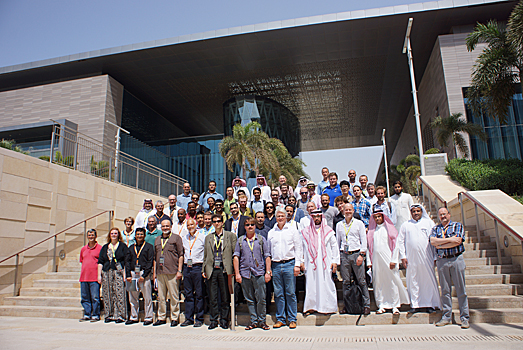Imaging and Active Tectonics of the Red Sea Region Workshop

Participants and organizers from this years Imaging and Active Tectonics of the Red Sea Region Workshop.
Saudi Arabia is a natural laboratory for studying active tectonic processes, including rifting, volcanism, and earthquakes, and how these shape local geologic features. The spectacular geology of the Arabian Peninsula offers the opportunity to investigate the formation and evolution of the Earth's upper-most geological layers (i.e. the continental lithosphere). These active processes provide crucial information on how the lithosphere is deformed and modified, and how these processes drive volcanic and earthquake hazard. This information formed the backbone of the discussion at the Imaging and Active Tectonics of the Red Sea region workshop.
The Imaging and Active Tectonics of the Red Sea region workshop, held between Tuesday, March 10 and Friday, March 13, gathered over 20 international speakers and 30 In-Kingdom researchers to KAUST with the aim of developing an improved understanding of seismicity, seismotectonics, volcanic activity and the Earth structure of Saudi Arabia and the region.
Scientists and researchers attended from countries that surround the Red Sea (Eritrea, Ethiopia, Yemen, Egypt, and Saudi Arabia), and from the U.S. and the U.K., France, Brazil and South Korea, along with representatives from the Saudi Geological Survey and the United States Geological Survey, as well as from KACST, KSU, KAU, KFUPM and Saudi Aramco.
Describing the event, Martin Mai, Professor of Geophysics, Division of Physical Sciences and Engineering (PSE) said: "We are very proud to have attracted a very distinguished set of both local and international speakers. It is also an opportunity to present KAUST and its research, facilities, students and post-docs to In-Kingdom and international visitors who otherwise might not visit KAUST. Throughout the event we hope to facilitate international collaboration and data exchange."
This is the second workshop on this topic at KAUST; the previous workshop was held in 2011.Co-organizer, Prof. Sigurjon Jonsson, Associate Professor of Geophysics, Division of Pysical Sciences and Engineering (PSE), further highlights the objective of this year's workshop: "The goal is to gather more information about new ideas, data, results from the field that address scientific questions on the evolution and present state of the Red Sea and the Arabian plate."
This workshop is part of ongoing collaborative research efforts in Saudi Arabia in the fields of monitoring and modeling seismic and volcanic activity in the Red Sea Region. "Volcanic activity here is ongoing, recent volcanic activities in the Southern Red Sea lead to the birth of new islands. As recently as May 2009, a volcanic dike intrusion in the area of Harrat Lunayyir (200km north-west of Madinah) caused an intense seismic swarm that culminated in a magnitude 5.7 earthquake. Earthquake and volcano hazard are immense challenges in times of rapidly growing societies that expand spatially and in density, with ever larger infrastructural assets at risk. As the coastal regions of Saudi Arabia continue to develop and grow, we need to understand and quantify the natural hazards of the area that are caused due to earthquakes and volcanoes," Mai said.
The four-day workshop consisted of presentations, a poster session, topical breakout meetings, a general discussion session, a geological field trip, plus a "state-of-knowledge" review on the tectonic evolution of Red Sea. A wide range of presentations were given in three main focus areas, namely: "Structure and Tectonics" of the Red Sea and its relation to the East African Rift, "Seismic Imaging and Earthquake Activity" that help to illuminate the geodynamic processes occurring in the Earth' interior underneath the Arabian Plate, the Red Sea, and the Afar Plume, and "Deformation and Volcanism" as manifestations at the Earth' surface of its deeply rooted geodynamics.
Participants discussed strategies and avenues for future international collaborative research, in partnership with Saudi universities, In-Kingdom institutions and global research partners. The research findings presented at the workshop, and the programmatic cooperation that was discussed during the meeting will greatly benefit the international research community as well as the scientific developments at KAUST, but most importantly the Kingdom.
By David Murphy, KAUST News

